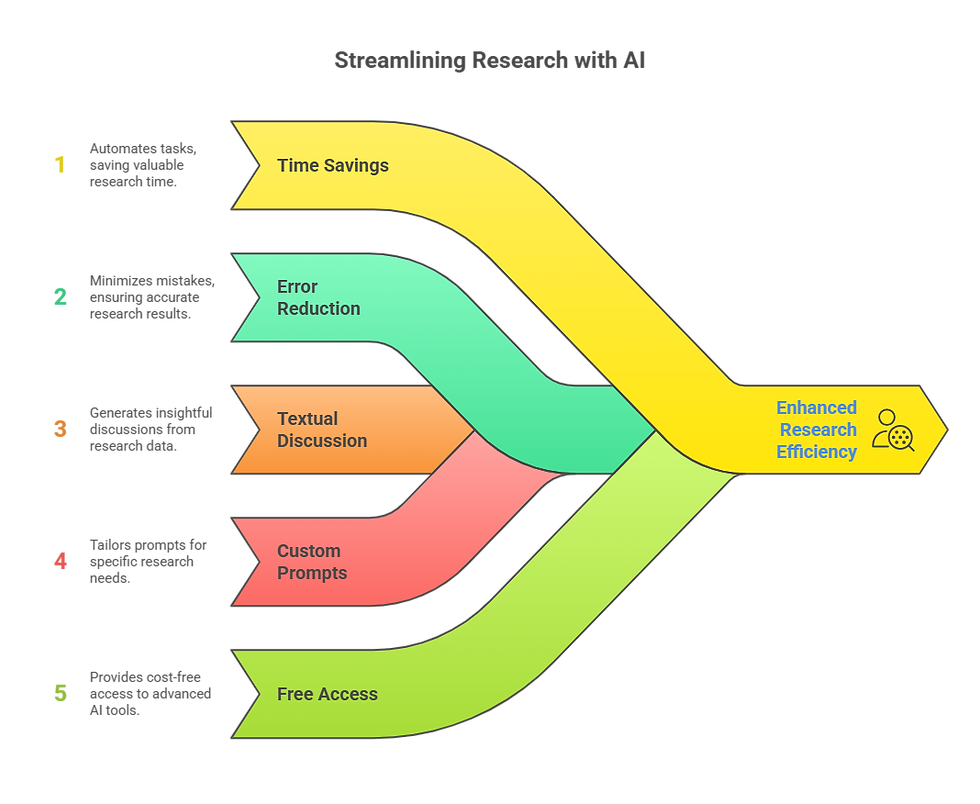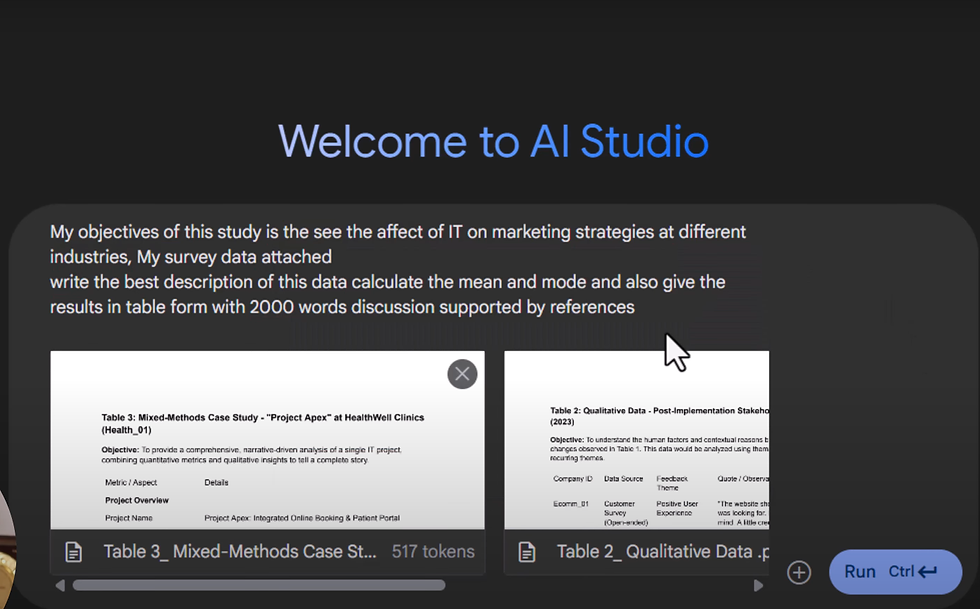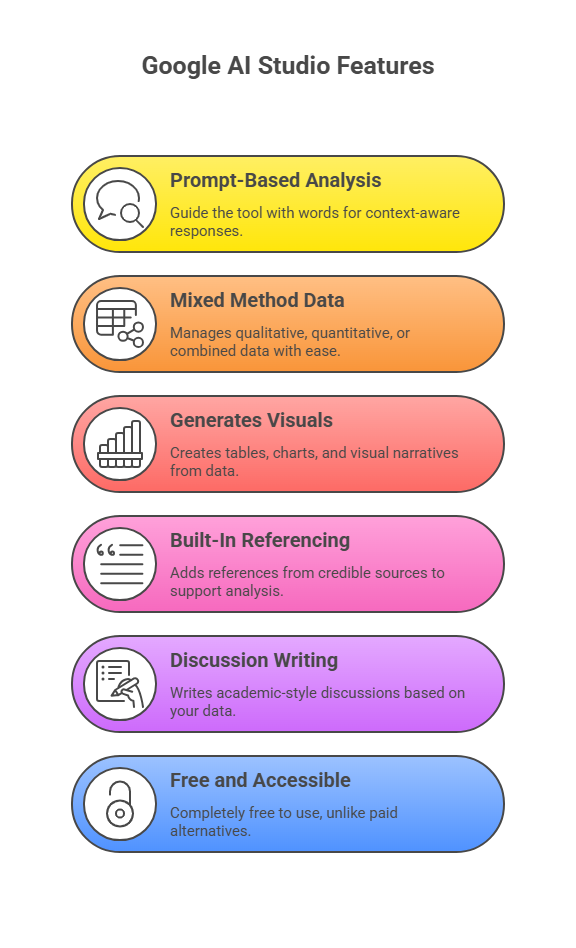Google introduces NEW FREE Feature to Analyse Complex Qualitative Data | AI Tools for Data Analysis
- Sumra

- Jul 19
- 4 min read
If you’ve ever worked on a research project involving surveys, questionnaires, or case studies, you probably know how difficult it can be to analyze complex qualitative data. While many paid tools offer features for deep data analysis, not everyone can afford them, especially students and early-career researchers.
But here’s the good news: Google has launched a powerful and free AI tool—Google AI Studio—that simplifies the process of analyzing qualitative (and mixed-method) data. It’s not just a tool; it’s an intelligent assistant that can read your data, understand your research problem, generate statistical results, summarize findings, and even visualize them—all in one place.
Let’s dive into how it works and why this free feature is a game-changer for data analysis.
Google AI Studio for Data Analysis
Google AI Studio is an online platform by Google designed to let users experiment with AI models using their own datasets and prompts. While it’s generally used for various AI applications, researchers are now discovering how well it works for qualitative and mixed-method data analysis.
This tool is free to access and comes with a clean interface where you can upload survey files, describe your research problem, and give specific commands for analysis. From writing summaries to generating mean and mode calculations, Google AI Studio acts like a virtual research assistant that follows your instructions in real-time.
Why It’s Important for Researchers
Analyzing qualitative data used to mean hours (or even days) of coding responses, looking for patterns, and writing long summaries manually. Tools that automate this process have always been expensive—until now.
Here’s why Google AI Studio is such an important tool:
It saves time by automating complex analysis
It helps reduce human error
You can generate textual discussions and visualizations
It allows custom prompt writing to suit your study
It’s 100% free

Step-by-Step Guide to Using Google AI Studio
Open Google AI Studio
You can find it easily via search or access it from the link in your browser.
The layout is clean, and no special software is required.

Click the Plus (+) Button
This allows you to start a new project.
Upload Your Data Files
Upload tables from your surveys, interviews, or any qualitative data.
Enter a Detailed Prompt
Describe your research topic, objective, and methodology.
Example: “Write the best description of the survey data, calculate mean and mode, generate a table, and provide a 2,000-word discussion supported by references.”

Let Google AI Studio Process
It reads, interprets, and breaks down your data to provide insights.
Copy or Export Results
You can save the generated content and even download visuals like charts.
Repeat with New Prompts
Ask for bar charts, summary reports, or explanations.

📊 Features That Make Google AI Studio Stand Out
Here’s what makes Google AI Studio different from other tools on the market:
1. Prompt-Based Qualitative Analysis
You guide the tool with your words. It understands context and adjusts its responses.
2. Handles Mixed Method Data
Whether your data is qualitative, quantitative, or both, it manages the complexity with ease.
3. Generates Tables, Summaries, and Visuals
Ask it to create tables, bar charts, or visual narratives based on your uploaded data.
4. Built-In Referencing
The tool can add references from credible sources to support your analysis. (You’ll still need to double-check them.)
5. Discussion Writing
Based on your data, it writes a full-fledged academic-style discussion, saving you hours of time.
6. Free and Accessible
Unlike paid tools such as NVivo or Atlas.ti, Google AI Studio is completely free to use.

🧮 Real Example from a Research Project
Let’s say you’ve conducted a study with three data tables:
Pre- and post-test survey results
Open-ended qualitative feedback
Cross-industry comparisons using mixed methods
Once you upload these files and provide a clear objective, Google AI Studio:
Calculates averages
Highlights relationships between variables
Provides interpretation
Write a meaningful discussion
Suggests visuals like bar charts and line graphs
You can ask it: “Describe the data, calculate mean and mode, generate visuals, and write a detailed 2,000-word discussion with references.” And you’ll get exactly that.
Curious about smarter data analysis? Read this Carousel
🔍 Why Google AI Studio Stands Out Compared to Paid Tools
Feature | Google AI Studio | NVivo / Atlas.ti | IBM SPSS / MAXQDA |
Cost | Free | Paid | Paid |
Easy Interface | Yes | Moderate | Moderate |
AI-Powered Prompting | Yes | No | Limited |
Handles Mixed Method Data | Yes | Yes | Yes |
Visual Output Generation | Yes | No (manual) | Yes |
Reference Support | Yes (AI-generated) | No | No |
Learning Curve | Easy | Medium to Hard | Medium |
Verdict: If you need a quick, easy, and powerful way to analyze qualitative or mixed data, Google AI Studio is the best option, especially if you don’t want to pay hundreds of dollars for premium tools.
Get My 6 Hours Customized Course "Mastery In Research Writing With AI Tools"
Conclusion: A New Standard for Researchers
Google AI Studio is not just another tool—it’s a complete, AI-driven workspace that helps researchers analyze, write, and visualize data with remarkable ease. For those struggling with data interpretation or writing blocks, this tool offers a real solution without costing a penny.
It’s time to move beyond complex spreadsheets and time-consuming analysis. With the right prompts and preparation, you can turn your research data into insights in just minutes.
Found this helpful? Share it with fellow researchers and explore more AI research tips at ScientificPakistan — where we make science simple.
Book 1:1 Consultation with Dr Rizwana







Comments